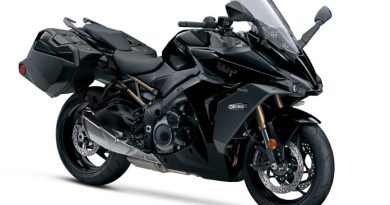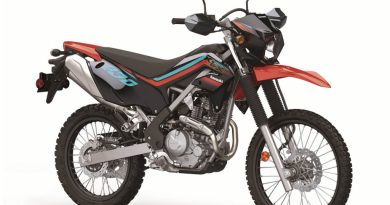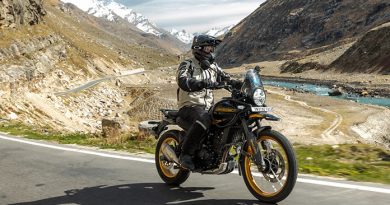The Harley-Davidson Evolution: The Bike that Saved the Motor Co.
Years in Production: 1984 – 99
Engine Size: 1340cc (80ci)
Horse Power: 48hp – 56hp
What’s the Big Deal? Forget the fact that this was a brand new engine in an all-new frame; this is the motorcycle that saved the company.
Famous Harley-Davidson Evo Riders: John Favill, Bill Davis, William Godfrey Davidson, Dave Zien
Tell me Something Weird About the Evolution: H-D was hell-bent on getting the Evolution engine right the first time. To make sure the bike was bulletproof, Harley ran a test engine for 100-hours at full-throttle. They then ran up a further 5,500 hours of testing, clocking up 750,000 miles.
As previously mentioned, the Shovelhead was a vast improvement over its predecessor and continued to improve right up until its demise in 1983. It was, however, painfully apparent that Harley-Davidson needed a new engine.
With their hands out, hoping for development dollars, the engineers turned to AMF. They were told sorry, nothing doing. Anti-AMF fans believe that this was due to sheer stinginess, but that isn’t quite right.
AMF earmarked serious money for such projects only to see it used on Federal mandates. These new laws concerned workplace safety and engine emission. To get up to compliance standards, the factory went through money faster than a millionaire octogenarian’s 20-year-old wife.
What Took so Long?
What took so long is a roundabout way of saying, that’s why the Evolution engine took seven years in development. Add to this, Harley needed a win to reverse financial and reliability issues. The pressure was on to get it right the first time.
Tasked with the job as head of engine design John Favill. British-born Favill, the man behind the highly successful Norton Commando engine, had made the move to Harley-Davidson in 1979.

The internal combustion engine turns thermal energy into mechanical energy, which is excellent. However, what’s not so great is the resulting heat generated from the conversion, which Favill knew, plagued the Knucklehead, Panhead, and Shovelhead.
There was only one way to address different thermal expansion rate issues between cast iron barrels and alloy heads. When it came to the new Evolution V2 engine, everything from head to sump must be aluminium.

The new cylinders and heads now worked together instead of against one another. The pistons could also run to far tighter tolerances. According to Favill, the new engine’s pistons typified the feeling of renewed hope that the Evolution gave to the company.
Related: Enjoy the Harley-Davidson engine sound from 1903-2020 right here
Grinding Pistons
“When I first joined the company, H-D was making their pistons on a grinding machine and a lathe,” recalls Favill. It became crystal clear that Evolution pistons needed a lot more precision in their manufacturer, so we contracted them out to German firm, Mahle.”
That may sound like no big deal, but every Harley-Davidson manufacturing facility was union-run. The AMF takeover in 1969 had resulted in volatile strikes. So with a 40 percent reduction in the workforce and 10 percent pay cuts for those who remained, H-D was wary of going head to head with the union.

All was not lost, though. The company’s mood was positive because the factory was now back in the hands of people, who ate, drank, and slept, Harley. According to John Favill, everyone was also aware that the new engine meant boom or bust. The situation was that simple.
When they went to the union to talk about outsourcing, instead of staunch resistance, what they received was cooperation. The lessons learned in the past and the realization that a better quality product would save everyone’s jobs won the day.
As a result of closer tolerances, in test conditions, rev for rev, the Evolution engine ran over 70 degrees F cooler than the Shovelhead. The overheating demons were finally on the back foot. Unfortunately, though, the Evo had some of its own peculiar foibles.
The Sound of the Harley-Davidson Evolution Engine
Crank up the Volume
The 1984-86 production run saw crankcases made from the sand-cast method. According to Donny Petersen’s ‘Unofficial Harley Technical Guide’ shortly after the Evo launch, the factory moved to die castings. They even had one-half of the crankcases manufactured in the Far East!
The change in casting production and inferior quality aluminum lead to porosity and cracking issues causing significant numbers of Evolution engine casings being changed under warranty. By 1992-3, the problem was much improved. Better still, from then on and up until its final production year, it kept on improving.’
Related: How to clean, condition and care for leather saddlebags

The all-new Evolution V2 engine was lighter, more reliable, produced more power in every gear and Harley fans around the world loved it. In its launch year of 1984, Harley Evo production stepped up to over 20,000 units. A considerable jump compared to the final year Shovelhead run of 13,818.
The model range covered the FX with its conventional rear suspension, the FXR, rubber engine mount, the FL tourers, and hidden amongst them, the very first FXST.
If the Evolution engine was a hit, then the Evo engine in a Softail frame knocked it out of the park. Harley threw everything but the kitchen sink at the FXST.
The bike featured a rear end with hardtail looks, hidden suspension, and custom looking rear fender over a fat back tire. At the front, wide kicked-out forks were topped off with a 21-ins front wheel.
The first production bikes also featured a four-speed box and kick-starter to keep the old-school vibe going, overall creating a show stopping motorcycle.
You’ve Been Framed
However, if the Evolution engine’s development owed a lot to John Favill, then the Softail frame owed Bill Davis everything. Davis was a skilled mechanical engineer and a long-time Harley fan.

Davis loved his ’72 Shovel and wanted to give it the hardtail treatment – minus the need for a chiropractor after every ride. A quick scout around and the only thing available were re-works of pre-war plunger suspension, and they didn’t float the Missourian’s boat.
Instead, Davis designed his hardtail style frame with hidden suspension. The rear frame triangle pivoted on a fixed point while the suspension was placed under the seat in line with the top frame rail.
Not an original idea, and Davis readily admits that he drew inspiration from the Vincent HRD set-up, but his application was nevertheless groundbreaking.
The resulting frame had the clean lines of a hardtail. Still, it took care of the lumps and bumps with around 3-ins of suspension movement courtesy of a snowmobile shock. In the spring of 1976, Bill Davis filed a US patent for the design, built himself a chop complete with 6-ins over forks, and rode straight to Milwaukee.
Here, Davis met with Louie Netz, a member of the Motor Co’s design team (who later became VP of Styling). They were also joined by Willie G, who cut short a beard grooming session to see what all the fuss was about!

The frame design received a positive reaction, but H-D didn’t bite. Undeterred, Davis went back to the drawing board to improve the design and make the necessary jigs to manufacture and sell it himself.
The bike’s single-shock got switched for a twin-shock. Through trial and error, it was eventually relocated to underneath the transmission.
Pay up Sucker
To cut a long but fascinating story short, Davis took on a business partner and called their company Road Worx. Shortly after, frames started flying through the door. At which time, surprise surprise, H-D decided to play ball.
Harley’s check was light, so Road Worx dug in for the long haul and secured funding to expand. The future looked rosy until a colossal fight ended with the business partner walking, leaving Davis saddled with all the debt.
This time, H-D came up with a better offer, and on January 6th, 1982, they bought the patents, prototypes and jigs. Just over one year later and only needing to tweak the frame to take the Evo engine, the world got a sneak preview of the all-new Harley- Davidson Softail.
Within a year of its launch, all models switch to belt final drive, and by 1987, production of Big Twins is scheduled to increase by 30 percent. The news is just in time for the company to start trading on the New York Stock Exchange.
To mark this occasion, 25 H-D big-wigs ride a fleet of Evos from a Harley dealership in Queens to Wall Street. They were followed through New York streets by ten limo’s, two Harley tractor-trailers, and a 40-feet motorhome.

To ensure the event got indelibly stamped in everyone’s minds, Harley was now playing in the big leagues, CEO Vaughn Beals posed on a Softail Heritage. It’s the only time a motorcycle has been allowed on the floor of the Stock Exchange.
The following years saw the Motor Co concentrating on improving an already great motor with small tweaks. The Keihin carb increased in size from 38-mm to 40-mm, and a more powerful starter motor helped with hot starts.
In 1995, to celebrate the 30th Anniversary of the Electra-Glide, the Evolution powered Ultra Classic became the first Harley to get sequential fuel injection.
The Beginning of the End?
The advent of EFI is an interesting milestone in the story of the Evolution engine. Although carbs wouldn’t be fazed out entirely for another 12 years, by 1995, increased environmental regulations were already making life more difficult for the normally aspirated combustion engine.
It would also be these very laws that would eventually sound the death toll for the Evo. Despite some CVO models still offering highly tuned Evo engines in 2000, 1999 saw the last production Evolution roll off the line. Production of Big Twins peaked that year at 135,317 units, making almost 850,000 Evolution powered bikes cruising around the planet.

Despite the management buyout and the newfound enthusiasm that flooded through the factory, the Evolution engine is still credited with saving the Motor Company.
Related: TOP-10 Retro Motorcycle Helmets
However, significant restructuring, cuts in the workforce, JiT ordering systems, 400,000 HOG members, and the launch of the Motor-clothes range (worth over $100m per annum) all played their part in its financial stability.
The Golden Years
These were the factory’s golden years, and brand awareness in the late nineties was through the roof. A fact confirmed in 1997 when H-D spent not $1 on advertising and still couldn’t keep up with the demand for their motorcycles.
We’ve already seen how each new Harley engine has ushered in the next generation of iconic models. However, the Evolution engine provided the power base for some of H-D’s most well-loved and visually arresting bikes.
| Model | Year | Features |
| FXST | 1984 | The Daddy of them all. Softail frame with hidden suspension under the bike |
| FLST | 1986 | The Heritage- big wheels, big fenders, big presence |
| FXSTS | 1988 | The Springer- modern spin on vintage forks, awesome looks. Who cares if they bottomed out |
| FXSTF | 1990 | The Fatboy – Solid wheels, all silver, and all attitude |
| FXR | 1992 | Last year of the Eric Buell tweaked, three-point rubber mount Evos. Probably the best handling Harley ever |
To begin with, is the bike that kicked it all off in 1984, the FXST. The motorcycle had classic chopper dimensions with the frame forming a straight line from the steering head to the rear axle.

The kicked out front forks ended in a 21-ins wheel, and the location of the footrests and controls had the rider, feet first. The phrase’ design classic’ gets used repeatedly when looking through the H-D back catalog, but the FXST deserves the title.
Next off the line in 1986, came the Heritage. This full-on cruiser taking a trip down nostalgia boulevard became one of H-D’s most-loved models. The bike oozed ‘Hydra-Glide’ style right down to the floorboards, studded saddlebags, and 16-ins front wheel.
The Heritage made baggers cool once more. It also felt more maneuverable and faster than a full-on tour bus.
If the Heritage made people do a double-take, then the 1988 Springer stopped them dead in their tracks. It did me, that’s for sure. I set eyes on my first Springer in Orlando, Florida, when it launched. On my return to the UK, I told my local H-D dealer I had to have the first one to land on British soil.
The next milestone in Evo history came in 1990, and it’s filled-in 16-ins wheels and silver paint job made the Fat Boy stand out from the crowd.
Beauty, though, like conjunctivitis, is in the eye of the beholder. While some consider Willie G to be more of a ‘borrower’ rather than an innovator when it comes to design, there is no doubting his ability.
The man can dramatically restyle a bike using the same basic footprint.

Yes, the faster, cooler running, more reliable Evolution engine provided the best opportunity for Harley to get back on their feet. However, without the defined styling to accompany it, the company’s return to the top may have taken a lot longer.
As cliché as it may sound, Willie G earns a place in our Evo Royalty section for one simple fact. Of all the models he designed during the Evo period, H-D dealerships pre-sold every single bike before it even left the assembly line.
Before William Godfrey reads this and his head gets too big for his beret; he also came up with duffers. I give you the 1997 Heritage Springer.
I can see where he was coming from. If the Springer is great and the Heritage brilliant, combining the two would be awesome, right? Wrong, the bike outfitted with fringe, concho’s, tassels, faux saddles, and dual-sided pipes had every clichéd vintage gewgaw thrown its way.

Dolly Parton’s Purse
Unfortunately, instead of a bike that tapped into the company’s rich past, it ended up looking not dissimilar to one of Dolly Parton’s purses!
Regardless, let’s return to Evo riding royalty. No story on this amazing engine would be complete without mentioning the Million Mile Man, Dave Zien.
The former Wisconsin State Senator bought a Harley-Davidson FXRT in 1991, which he called Suzanna. Eighteen years and four marriages later, Zien rode it for the last time. He made the journey to the Sturgis Museum and Hall of Fame, and with 1,003,570 miles on the clock, he handed it over along with his riding boots for permanent display.
Related: TOP-10 Retro Motorcycle Gloves

Others may have clocked up a 1,000,000 miles during their lifetime, but Dave is the only man in the world to have achieved it on one bike, his trusty Evo Sport Glide.
Throughout his term in office, the former Marine has fought tirelessly for veterans and biker’s rights. If you think handing his Harley over was the end of his road trip, then think again.
In 2009, Harley-Davidson gifted Dave with a new Road Glide to recognize his work and brand loyalty. Sadly, two years later, an unlicensed SUV driver ran into him. In the resulting accident, Dave lost his left leg below the knee.

Three Wheels on his Wagon
Did that stop Dave Zien? No way, he now rides the nation’s highways on board a Harley trike. What’s more, his total mileage to date is 2.7 million miles and counting. Long may he roll.
During its 15-year reign, Harley-Davidson produced almost 850,000 Evolution engine powered Big Twins. By the end of its run, the engine was oil-tight, reliable, and pumped out stump-pulling torque.
Unlike the Harley engines of the past that couldn’t keep up with the competition’s performance and reliability, the only reason H-D called a halt to the party was primarily down to emission laws.

The EPA deemed that the Induction roar and cam whine from the Evolution engine exceeded their limits. Harley’s only way forward was to produce a more powerful but heavily restricted engine with two chain-driven cams.
It’s not surprising that the Motor Co had been working on just such an engine since the early ’90s, but yup, you guessed it, that’s another story.

The post The Harley-Davidson Evolution: The Bike that Saved the Motor Co. appeared first on Old News Club.




